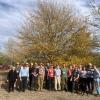Editor's Picks
Plant Focus
Presentation given at the XX International Botanical Conference, Madrid, Spain, July 21–27, 2024.
Authors:
Maribel Arenas-Navarro1,2, Ken Oyama3, Fernando Pineda-García3, Andrés Torres-Miranda3, Horacio Paz1, Felipe García Oliva1
Affiliations:
1. Instituto de Investigaciones en Ecosistemas y Sustentabilidad (IIES), Universidad Nacional Autónoma de México (UNAM), Michoacán, México
2. Facultad de Estudios Superiores Iztacala (FESI), Universidad Nacional Autónoma de México (UNAM), México, México
3. Escuela Nacional de Estudios Superiores (ENES) Unidad Morelia, Universidad Nacional Autónoma de México (UNAM), Michoacán, México
Abstract:
Seedling growth and morphology reflect functional responses to habitat because their establishment relies on the development of resource-acquiring organs and their capacity to respond to the environment. Oak species contribute significantly to above-ground biomass and biodiversity in Northern Hemisphere Forest ecosystems. Although morphological and physiological differentiation has been studied in oaks, it is necessary to conduct studies to analyze the ecological strategies at the seedling stage. In this study, we conducted an experiment under controlled conditions to assess how interspecific variation in functional traits of oak seedlings varies in relation to their native climates. We selected three oak species from dry lowland forests and three from mesic highland forests of Mexico. We analyzed the trade-offs among leaves, stems, and roots that drive functional differentiation between dry and mesic oak species. We examined trait-by-trait relationships, constructed interaction trait networks, and then quantified the overlap of functional space at both the species and environmental group levels. Our results showed significant differences among environmental groups, primarily in leaf carbon:phosphorus ratio, stem water content, and biomass allocation. Oak species from dry environments allocate biomass to roots to obtain water and nutrients as a drought adaptation. Meanwhile, mesic oak species allocate more biomass to leaves, with higher leaf nitrogen and phosphorus concentrations and stem water content. Both environmental groups showed trait-by-trait relationships; however, we found that the pattern of coordination of traits was different between the dry and mesic oaks. This supports the idea that the selective value of the same traits differs under different environmental conditions. Finally, we found significant segregation of the functional space among species in the same environmental group, highlighting the diversity of ecological strategies in oaks. Variations in plant functional traits and different elemental compositions among oak species promote diversity in ecological strategies.
















